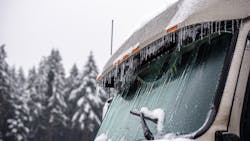How to prep ADAS technology for the winter
You may not be thinking about winter yet, but it is never too early to start preparing vehicles for winter weather. In mid-October we saw the first snow flurries of the season in Chicago—which is extremely early. Luckily, they were just flurries and we didn’t see any accumulation. But it’s always good to be prepared for winter weather sooner rather than later, as you never know quite what will happen from one year to the next. For example, in 2019 the Windy City received 4.6 inches over Halloween.
An unprepared commuter might be a little late for work, but a lack of winter preparedness is far more costly at the fleet scale. That’s why fleets should stat winterizing in before the first snow falls, with typical system checks including oil, coolant, hoses, wires, lights, tire pressure, etc. They may need to add another line item to your winter prep checklist—sensors and cameras.
Fleets are adopting more and more technology to help improve safety and fuel efficiency, including advanced driver assistance systems (ADAS) such as lane departure warning systems, collision avoidance systems, adaptive cruise control, electronic stability control, blind spot monitoring and more, and you will need to check all the sensors, cameras, lidar and radar used to operate those systems.
ADAS technology is not only designed to improve safety, but a few of them—including adaptive cruise control and tire pressure monitoring systems — can help improve fuel efficiency as well.
These technologies can be sensitive even on the best days, in the best weather, but ADAS sensors and cameras can become caked with snow, ice and road salt and no longer “see” the road, which can cause operational failures.
If your vehicle is equipped with ADAS technology, take the time to learn where sensors are located. These will be the key areas of the vehicle to keep clean in order for the ADAS system to work properly.
Blind-spot monitoring uses sensors near the rear bumper to determine if a vehicle is coming up behind you. Snow can confuse radar signals, limiting their effectiveness. Keep the rear bumper area free of snow and ice and use mud flaps to redirect road spray.
Read more: Best practices to avoid ADAS maintenance mishaps
Lane departure warning systems use video, laser and/or infrared sensors to detect visible road markings to warn if you are unintentionally crossing them. Sensors will have trouble detecting road markings that are covered by snow, slush, salt or ice. Be sure to clean mirrors and other areas where sensors or cameras may be mounted.
Forward collision warning systems use front-facing cameras or radar to take corrective action if your vehicle is about to collide with another. Like the systems above, sensors may be affected by snow, slush, salt or ice. Plus, slippery roads mean longer braking distances; even if you get a warning, you may not be able to stop in time. Make sure the front bumper area and grille are free from snow, ice or salt so sensors have a clear view.
To clean these areas, use an automotive-specific detergent so you don’t damage paint or other vehicle finishes. Also be gentle as salt and dirt can abrade paint. Use a soft cloth or lint-free towel to dry the areas once they are cleaned.
During pre-trip inspections, make sure that the entire vehicle is clear of snow, salt and ice. Note that if you are driving in snowy weather, you may need to clear off the sensors more than once during your route.
Future ADAS systems may be equipped with self-cleaning sensors, but in the meantime, make sure that you are keeping sensors clean.
Kim Ehrenhaft is design director at the North American Council for Freight Efficiency. In this role, she works on NACFE’s Confidence Reports and Guidance Reports and is responsible for its social media efforts. Ehrenhaft has been involved in the trucking industry since 1993 and has worked on various trucking industry related publications.
About the Author

Kim Ehrenhaft
Design Director | North American Council for Freight Efficiency
Kim Ehrenhaft is design director at the North American Council for Freight Efficiency. In this role, she works on NACFE’s Confidence Reports and Guidance Reports and is responsible for its social media efforts. Ehrenhaft has been involved in the trucking industry since 1993 and has worked on various trucking industry related publications.
